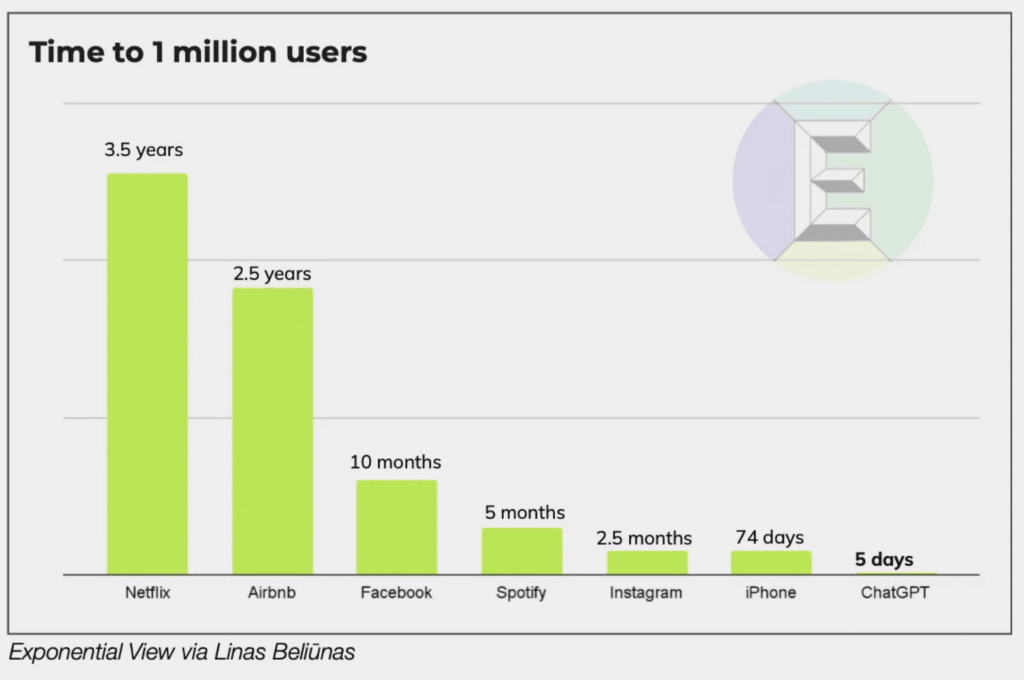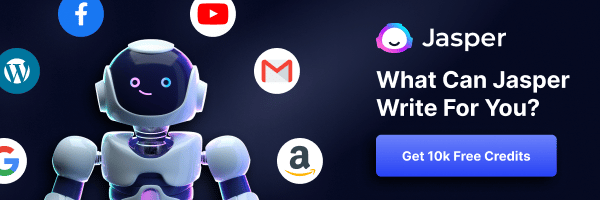You’ve probably noted the remarkable rise of ChatGPT. In a short time, it’s become a game-changer in the field of artificial intelligence (AI) and has the potential to revolutionize the way we work and learn.
In this episode of the Leading Learning Podcast, we explain what ChatGPT is, how it works, and its implications for both learners and providers of learning. We also discuss concerns about and limitations of ChatGPT and what learning businesses need to consider when using it.
To tune in, listen below. To make sure you catch all future episodes, be sure to subscribe via RSS, Apple Podcasts, Spotify, Stitcher Radio, iHeartRadio, PodBean, or any podcatcher service you may use (e.g., Overcast). And, if you like the podcast, be sure to give it a tweet.
Listen to the Show
Access the Transcript
Download a PDF transcript of this episode’s audio. (Note that content generated by ChatGPT is highlighted in the transcript.)
Read the Show Notes
[00:00] – Intro
What ChatGPT Is and How It Works
[01:03] – ChatGPT is a large language model trained by OpenAI. It uses machine-learning techniques to generate human-like text based on a given prompt or conversation. Essentially, it can hold a natural conversation with a human.
GPT stands for Generative Pre-trained Transformer, and ChatGPT, which was launched on November 30, 2022, is built on GPT-3. The addition of a familiar chat interface to GPT-3 was intended to make it much more user-friendly for the average person who may still feel pretty daunted by the prospect of using AI.
In the five days following the launch of ChatGPT, more than a million users signed up. ChatGPT was up to 2 million users in ten days, which is truly astonishing. Below is a chart showing the time it’s taken for other well-known platforms to get to 1 million users.

If you haven’t already, we encourage you to sign up for a ChatGPT account at https://chat.openai.com/chat. There are times it’s not accessible because so many people are using it, but wait to get in if you have to. ChatGPT is free during what OpenAI is calling the “research preview,” but that will change.
You access ChatGPT online, type in a prompt (a question or a request), and ChatGPT responds almost immediately. You can then respond to its response, and a conversation can happen.
To support the conversational feel, ChatGPT remembers what you typed earlier in the chat, and that allows you to provide additional information and corrections that can then inform future responses from ChatGPT.

How ChatGPT Is Being Used and Might Be Used by Learning Businesses
[03:36] – ChatGPT is already used in a number of educational settings. Some universities are using it to create personalized study plans for students based on their goals and learning styles. Others are using it as a tutor, providing students with instant feedback and support as they work through online course materials.
There are also companies that are using ChatGPT to create personalized learning experiences for professional development and continuing education. These programs can be tailored to the specific needs and goals of the individual learner, and they can be accessed anytime, anywhere.
The ability to create personalized learning experiences that are tailored to the needs and goals of the individual learner has the potential to significantly improve the effectiveness of continuing education and professional development programs.
ChatGPT also has the potential to democratize access to education and training. By providing instant feedback and support, ChatGPT can help learners overcome roadblocks and stay motivated as they work towards their goals.
ChatGPT could serve as an AI-driven coach Something like ChatGPT could make coaching more affordable and accessible, so not just for the high-paid executives anymore. There are already a number of AI-based coaching platforms out there, like Cultivate and Edthena.
Check out our related episode “At the Intersection of Coaching and Learning with Jen Lewi.”
ChatGPT has the potential to improve the quality of lifelong learning and professional development and make it more accessible to a wider range of people.
When it comes to some of the other applications of ChatGPT, there are two clear areas where this technology has implications—for learners and for those providing the learning.
Implications of ChatGPT for Learners
ChatGPT can help learners solve problems and complete assignments. Learners can type in math-based word problems for ChatGPT to solve. ChatGPT can troubleshoot computer code.
This means the value of assignments like “Write 500 words about effective leadership” or word-based math problems could radically change.
A learner could simply copy and paste a ChatGPT response and use it as a short essay, making only a few minor edits. Or a learner could take the answer that ChatGPT gives to a word problem and use that without understanding the operations that went into solving the problem.
There’s the potential for cheating or misuse, but this brings back memories of the hubbub about calculators in math class long ago.
Calculators were banned for a while; then instructors came to embrace them and, instead of forbidding them, started teaching how to use them effectively. I think that ChatGPT and other conversational AI tools have the chance to become a new and accepted tool—like calculators, like the Internet.
Jeff Cobb
Leading Learning Newsletter
[07:39] – As someone who listens to the Leading Learning Podcast, you should know about the Leading Learning newsletter.
The newsletter is inbox intelligence for learning businesses and helps you understand the latest technology, marketing, and learning trends and grow your learning business. Best of all, it’s a free resource. As a subscriber, you’ll get Leading Links, our monthly curated collection of resources to help you grow the reach, revenue, and impact of your learning business; the podcast digest, a monthly summary of podcast episodes released during the previous month; plus periodic announcements highlighting Leading Learning Webinars and other educational opportunities designed to benefit learning business professionals.
Subscribe for free. Or, if you’re already subscribed, point a colleague to leadinglearning.com/inbox.
Implications of ChatGPT for Learning Businesses
[08:37] – ChatGPT clearly can serve learners, and a lot comes down currently to the learners’ ethics in terms of whether that purpose is getting out of work or actually supporting learning.
On the learning business side, ChatGPT also has clear uses.
ChatGPT could radically change how learning businesses make use of and interact with subject matter experts (SMEs).
An instructional designer, for example, could use ChatGPT to come up with an initial list of essential things learners need to know about recognizing signs of dementia or about effective written communication. Then that list could be turned over to an SME for validation and refinement. Or vice versa. Or both.
Something similar could be done with assessments. You could use ChatGPT to generate questions to ask learners or ideas for assignments.
Before recording this podcast episode, ChatGPT readily gave us ten questions about diabetes when asked. It returned questions including those below:
- “What are the complications of diabetes?”
- “How is diabetes treated?”
- “Can diabetes be prevented?”
- “What new technologies are available for diabetes management?”
When we asked, “What would be a good assignment to give someone who needs to learn more about how to prevent diabetes?,” ChatGPT readily gave us six ideas, including those below.
- “Research the risk factors for type 2 diabetes and create a list of lifestyle changes that can help reduce the risk of developing the disease.”
- “Write an informational leaflet about the link between diet and diabetes prevention. This could include information about the role of different types of food, such as carbohydrates, fats, and proteins, in blood sugar control, as well as tips for healthy eating and meal planning.”
- “Create a plan for increasing physical activity in order to prevent diabetes. This could include finding fun ways to be more active, setting goals, and tracking progress.”
Those questions and assignment ideas aren’t earth-shattering. If you’re already an expert in this domain, you know that stuff. But, still, it’s impressive for AI generate this content based on basic prompts and simple directions.
E-learning authoring tools that are AI-based (e.g., (Nolej) are emerging, and they will almost certainly automate and improve on the kinds of scenarios we just shared.
Educational content is not all that ChatGPT will be used for. Learning businesses also have marketing needs, and ChatGPT can help there too.
ChatGPT can, for example, write drafts of course descriptions or conference session descriptions, or it can help with titles for blog posts, e-mail subject lines, and social media posts.
Again, we tried out these kinds of activities with ChatGPT using the prompt “Give me some title ideas for a blog post about using ChatGPT to support lifelong learning.” It returned the following:
- “ChatGPT: A Lifelong Learning Companion”
- “Revolutionizing Education with ChatGPT”
- “Leveraging ChatGPT for Self-Directed Learning”
- “Continuous Learning with ChatGPT”
- “Using ChatGPT to Enhance Your Learning Journey”
For learning businesses that need to feed the content machine to attract users to their site, AI-generated content can be a game-changer.
[12:57] – We have a license to Jasper.ai, a platform that leverages GPT and now ChatGPT to create both short-form and long-form content.

We operate in a specialized enough area (as do many of our listeners) that we don’t expect Jasper or ChatGPT to turn out exactly what we need, but it can turn out material that works well as a starting point. ChatGPT and similar tools can also be used to help you clarify your thoughts and produce content that you can build from, accelerating the pace at which you’re able to produce content.
As long as you provide your own lens and bring your own perspective and expertise to the content, content that starts from an AI tool can still be authoritative, expert-driven, trustworthy content. The AI tools allow you to produce content much faster and in a more targeted way.
I feel like this is the tipping point on AI that we’ve been waiting for. We’ve been talking about this for years, but I think it’s just been out of the reach of the ordinary person up until now. And I think that this can and will radically change how we learn and how we live.
Jeff Cobb
Concerns About and Limitations of ChatGPT
[14:37] – But it’s not 100-percent clear that ChatGPT will only lead to good things. There are some serious concerns about ChatGPT, which we want to touch on as well.
One concern is the potential for ChatGPT to perpetuate existing biases. If the data used to train the model contains biased language or information, ChatGPT may reproduce and amplify those biases in its responses. This could have negative consequences for marginalized groups, who may be disadvantaged or discriminated against as a result.
In a similar vein, ChatGPT can be used—or rather misused—for creating and spreading misinformation or information that’s simply wrong. And, unfortunately, ChatGPT can do that with even greater scale and speed than what we’ve already seen happening with misinformation. That could lead to what we would call mislearning.
Ezra Klein talked about ChatGPT in a recent episode of his podcast, which we recommend.
GPT, and really AI in general, is not yet very competent at determining the truth of content. To the extent that learning business and their SMEs do leverage something like ChatGPT to generate content, there will be an ethical obligation to assess the validity of that content.
Celisa Steele
Another concern is around cost and therefore accessibility down the road. Currently, ChatGPT is free, but it won’t remain free. Earlier, we mentioned that ChatGPT also has the potential to democratize access to education, but that democratizing potential will be undercut depending on the cost of accessing and using the tool.
Another ethical consideration is the potential for ChatGPT to replace human instructors or tutors. This could have implications for the employment of educators and raises questions about the appropriate role of AI in education.
Now is a good time to come clean and share that part of the content for this episode was produced by GPT. We asked it to produce a podcast script for a show about the implications of ChatGPT on the creation and consumption of lifelong learning, professional development, and continuing education, and we’ve incorporated some of what it generated.
We didn’t include anything that we don’t feel is true or accurate, and it’s only been a small percentage of our overall conversation.
If you’re curious to know exactly which parts of this episode were generated by ChatGPT, check out the transcript.
In using ChatGPT to generate a podcast script, it was interesting to see that it could do a reasonable job doing the work that two humans (Celisa and Jeff) usually do.
[18:49] – Finally, we’ll mention something that’s less of a concern and more of a limitation. ChatGPT has “limited knowledge of world and events after 2021,” according to its makers. ChatGPT wouldn’t be good to use for late-breaking news or much help to your learners or your learning business around current events or new discoveries.
Because of that limited knowledge of the world after 2021, ChatGPT could return incorrect information. Again, the makers acknowledge this, but it’s something to be aware of, particularly if you offer high-stakes learning or operate in a field or industry where things change often.
Despite those concerns and limitations, we are quite bullish on the possibilities, and we’re fascinated to see what this easy-to-use, competent, helpful, quick-to-respond artificial intelligence will mean for how we all learn, work, and live.
Celisa Steele
GTP-4 is on the horizon, and it will open up post-2021 information and the Internet more broadly. The next generation will take AI to new levels.
Our message is simple. Go try ChatGPT, and think about how you can apply it. What could ChatGPT or a similar technology do to improve the reach, the revenue, and the impact of your learning business?
[20:29] – Wrap-up
Sign up for a ChatGPT account at https://chat.openai.com/chat. (Accounts are currently free.)
To make sure you don’t miss new episodes, we encourage you to subscribe via RSS, Apple Podcasts, Spotify, Stitcher Radio, iHeartRadio PodBean, or any podcatcher service you may use (e.g., Overcast). Subscribing also gives us some data on the impact of this particular part of our content strategy.
We’d also be grateful if you would take a minute to rate us on Apple Podcasts at leadinglearning.com/apple or wherever you listen. We personally appreciate reviews and ratings, and they help us show up when people search for content on leading a learning business.
Finally, consider following us and sharing the good word about Leading Learning. You can find us on Twitter, Facebook, and LinkedIn.
Episodes on Related Topics:
- The Impact of Artificial Intelligence
- Three Big Technologies Changing the Learning Landscape
- Putting Foresight – and Artificial Intelligence – First with Jeff De Cagna – Part I
See also:



 Leading Links 2023 – Issue 1
Leading Links 2023 – Issue 1
Leave a Reply